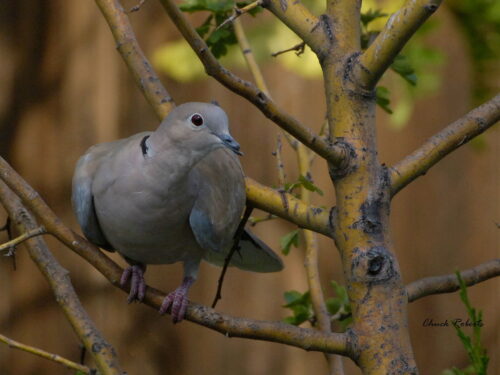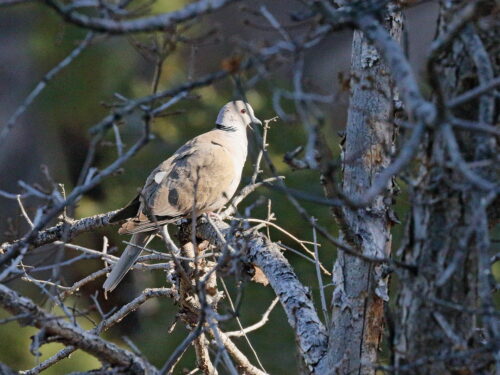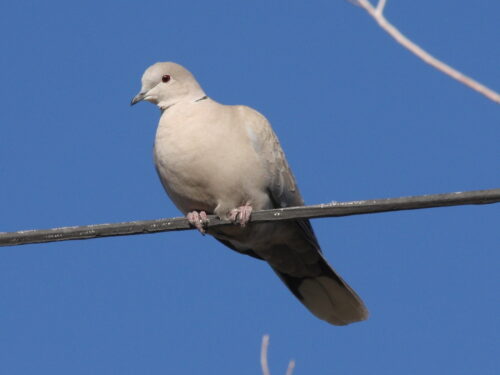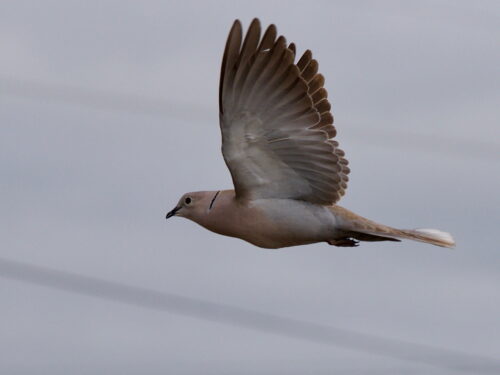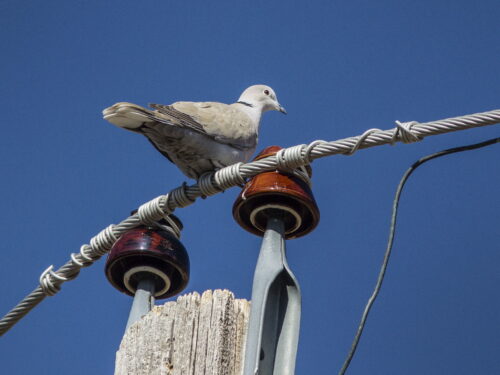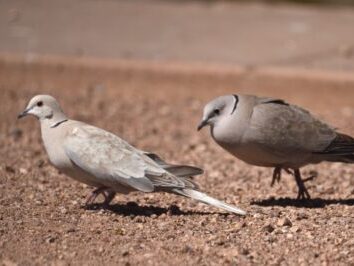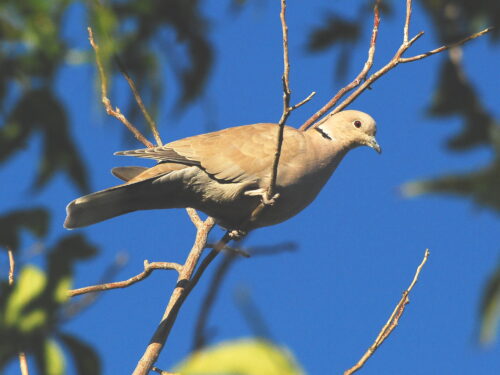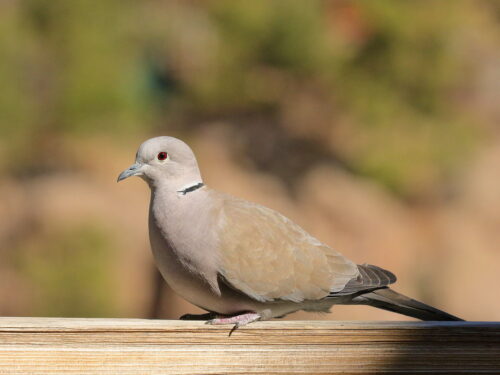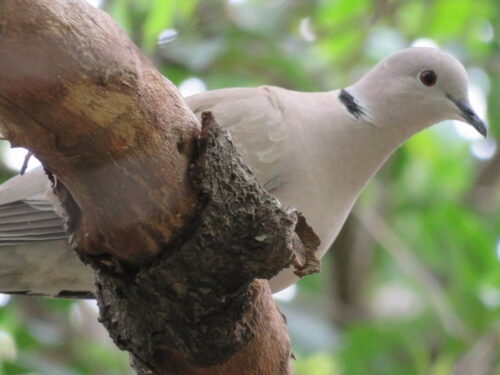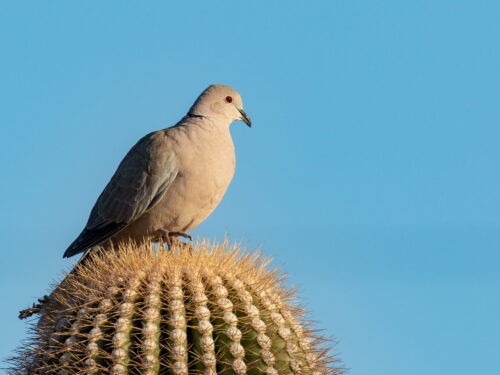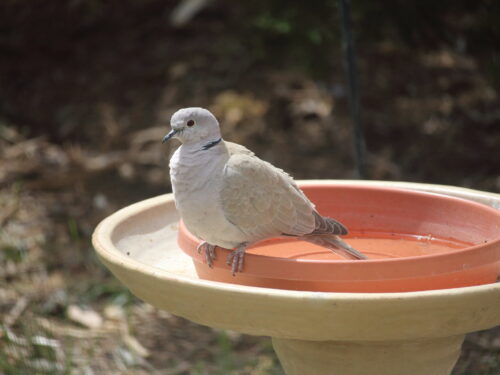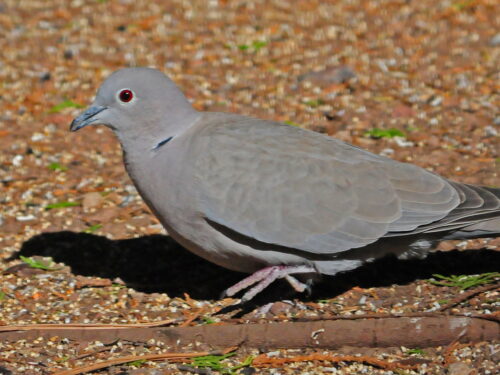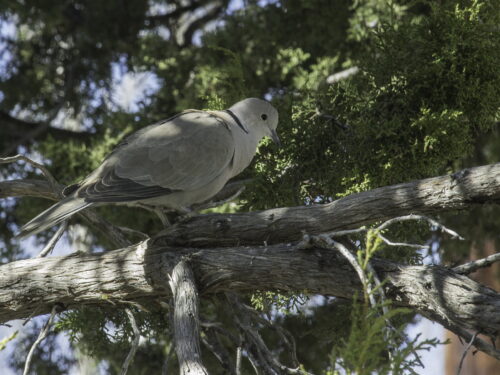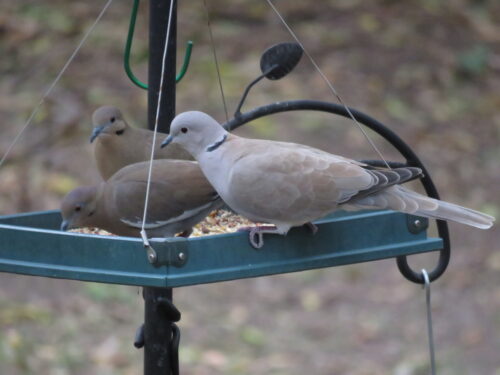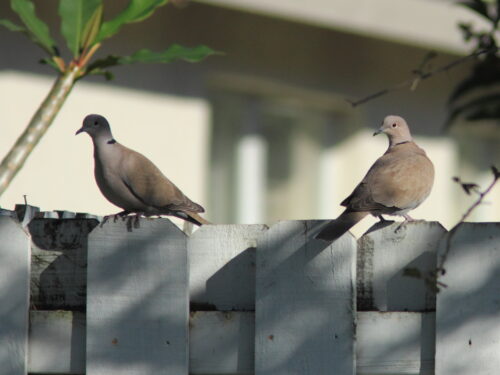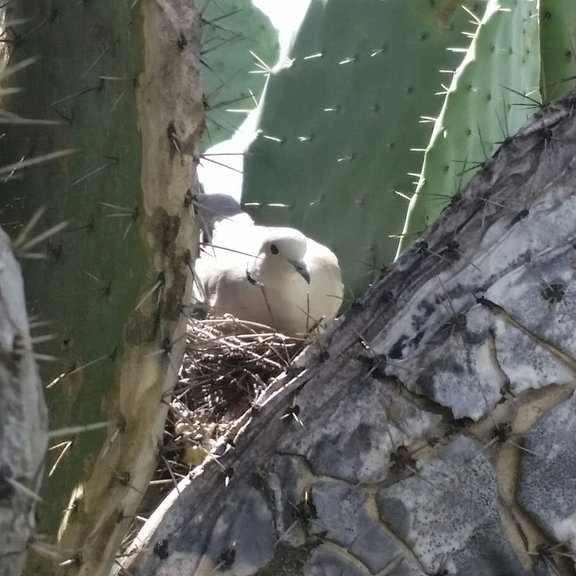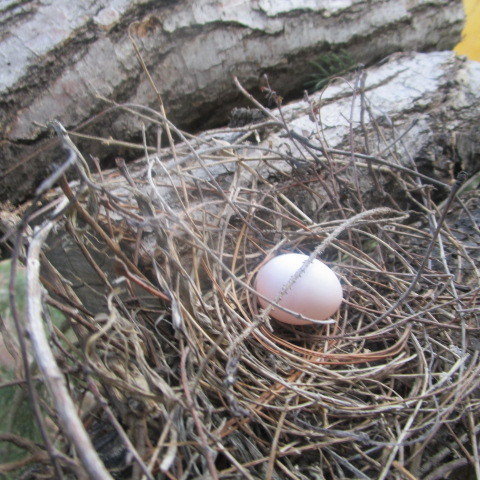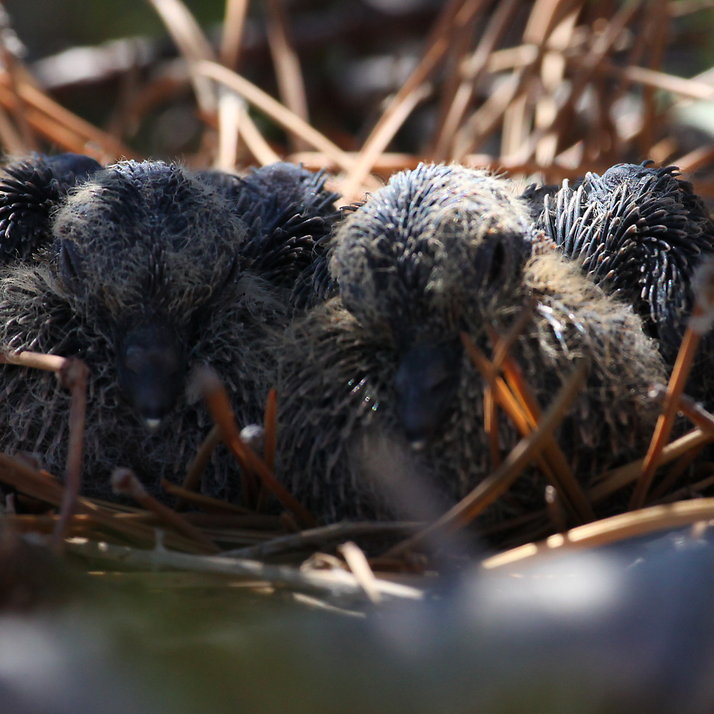Eurasian Collared-Dove
Scientific Name: Streptopelia decaocto
Type: Bird
Family: Columbidae (Pigeons and Doves)
Size: 13 inches long; 19 to 22-inch wingspan
Weight: 4.5 – 8.4 ounces
Life Span: up to 15 years
Physical Description
A Eurasian Collared-Dove is a chunky bird that is a grayish tan overall with whitish patches at the end of the long, broad tail and pinkish legs and feet. There is a half-black collar on the upper back of the neck that comes around to the front but does not form a complete circle.
Female Eurasian Collared-Doves look similar to the males. Juveniles are lighter in color and lack the black collar of the adults.
Adult
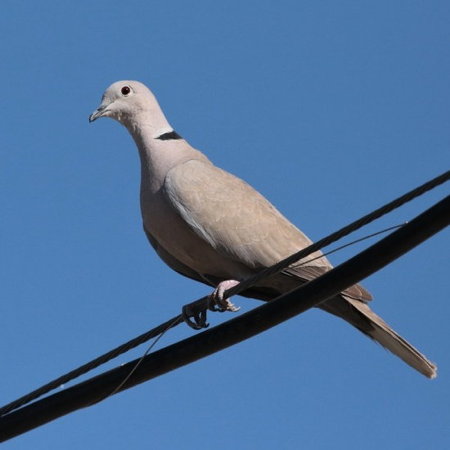
Juvenile
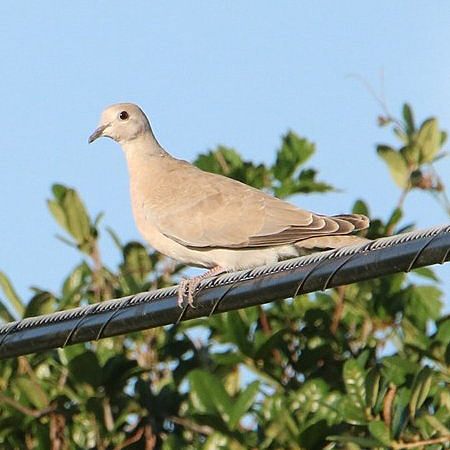
Range and Habitat
The Eurasian Collared-Dove is a native of India, Sri Lanka, and Myanmar as well as parts of Europe. Fewer than 50 doves were introduced into the Bahamas in 1974 where they soon escaped captivity and spread to mainland Florida. Since then this bird has increased its range to cover almost all of the United States, the southern part of Canada, and the northern portion of Mexico.
These doves seem to prefer suburban areas, but are found widely in open regions including in agricultural areas.
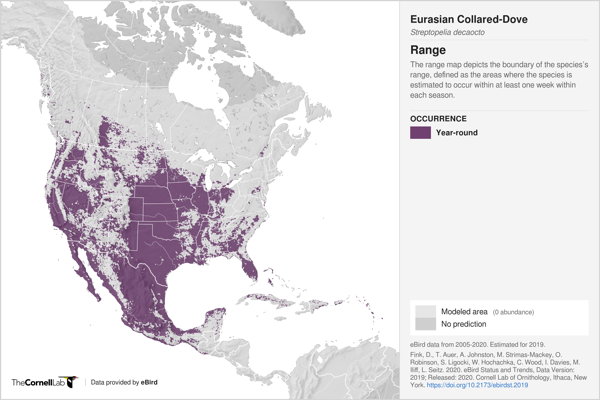
Diet
Eurasian Collared-Doves mainly eat seeds from grasses and cereals, along with some berries, insects, and other invertebrates. They will forage in flocks when not breeding, mostly by walking along the ground, but may flutter among the branches of trees or shrubs to take berries. They are attracted to platform feeders.
Behavior and Social Life
Eurasian Collared-Doves roost on utility poles, wires, and tall trees in open areas near feeding sites. Mainly ground foragers, they peck at grain and seeds scattered beneath backyard feeders and on feeding platforms, or spilled at farmyards. Flocks of 10 to several hundred doves may gather at prime spots. Although they can feed peacefully in mixed flocks, Eurasian Collared-Doves will also chase off other birds, including Mourning Doves, cardinals, and Blue Jays. The male advertises for a mate with an insistent koo-KOO-kook call from a high perch, repeating the call up to a dozen times in a bout, sometimes starting before dawn and continuing into the night. Calls are followed by a flight display in which the male flies steeply upward, clapping his wings, then descends with tail spread, often spiraling down to the same or a nearby perch. Once a pair has formed, males show females potential nest sites, usually in tall trees but occasionally on buildings. In between these “site visits” the pair vigorously preen each other. Male doves bring females sticks and other material for the simple nest, and aggressively chase away other collared-doves, as well as predators—venture too close and you risk getting hit by a flapping wing. The monogamous pair may raise up to six broods a year; the female can lay a new clutch while young are still in a previous nest.
Eurasian Collared-Doves communicate by giving incessant three-syllable coos or calling with a raspy, nasal, descending “heeeewww.”
They perch on telephone poles, wires, and in large trees and give incessant three-syllable coos. Their strong flight pattern features bursts of clipped wingbeats and looping glides. When walking these doves bob their heads and flick their tails. Eurasian Collared-Doves often feed at backyard seed feeders and on spilled grain in stockyards and around silos.
Territorial battles between rival males are not unusual and are often both fierce and long. Collared doves are extremely territorial and aggressive, they won’t hesitate to scare smaller birds away from feeding areas. The reason thought to be linked to their territorial streak is due to their high reproductive output.
Foraging
Cooing
Life Cycle
Eurasian Collared-Doves breed throughout the year, though this activity is much less in mid-winter. In order to attract a female, a male will fly up at a steep angle while beating its wings and then gliding downward while calling harshly and spreading its tail. The male then leads the female to potential nest sites in a tree or a manmade structure, letting the female pick the site. The male gathers sticks, twigs, and grasses while the female builds a flimsy platform nest.
The female lays 1 or 2 white eggs. Both parents incubate the eggs which hatch in about 2 weeks.
Such prolific breeding is helped by the eggs hatching after 14 days, and the young fledging just 17 days later. The young will leave the nest about 15 to 20 days after hatching and are on their own a week or so later.
Eurasian Collared-Doves often use the same nest for multiple broods during the year, and may even renovate an old nest.
Title
Ecological Role
Due to the fact that the Eurasian Collared-Dove is a relatively recent invasive species for the US, it is unclear what ecological role it will have. Biologists are actively tracking the impact it may have on native species. Some scientists have postulated that the Eurasian Collared-Dove may assume the niche that belonged to the now-extinct Passenger Pigeon whose hyper-social habits created cycles of forest disturbances and regeneration.
Interactions With Humans
The Eurasian Collared-Dove, as an invasive species, is not protected and has become a popular game bird throughout the southeast US and Texas. The monotonous cooing of these doves drives many people to distraction, while others enjoy it.
Interesting Facts
- The genus name (streptospeleia) for the Eurasian Collared-Dove is Greek: streptos meaning “collar” and peleia meaning “dove”.
- The species name (decaocto) comes from Greek mythology relating to a servant girl who the gods transformed into a dove so she could escape her unhappy treatment. The dove’s mournful cry is said to recall her former life.
- A group of doves may be called a “bevy”, a “cote”, a “dole”, a “dule”, or a “flight”.
- The feathers of a collared-dove tends to be so dusty that where a bird has hit a window will leave an imprint.
- The Barbary dove is the domesticated form of the collared-dove.
- There are several African species of doves that look similar to the Eurasian Collared-Dove.
- Flocks of upwards of 10,000 collared-doves have been reported in Europe.
- A significant part of a suburban Eurasian Collared-Dove’s diet is bread.
- The Eurasian Collared-Dove is not considered to be an agricultural pest but can be in a garden.
- Eurasian Collared-Doves are one of very few species that can drink “head down”, meaning they submerge their bills and suck up water as though through a straw.
- Some collared-doves have been known to rear up to five broods in a year.
- Unlike most birds, Eurasian Collared-Doves feed their newly hatched chicks a fat- and protein-rich “crop milk” that comes from liquid-filled cells that slough off the lining of the crop of the parent.

